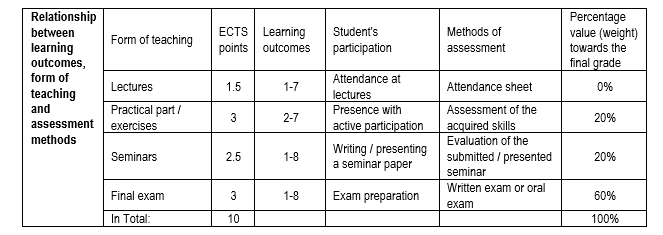The objectives of the course are:
Introduce students to the changes resulting from early brain damage, brain damage at birth, congenital deformations, genetic disorder, chromosomal disorder, etc.
Introduce students to the early development of the brain.
Show students the basic diagnostic methods for the detection of early brain dysfunction. Show the latest measures taken in case of detected brain damage (especially birth hypoxia). Show basic elements of the examination of newborns and infants.
To present students with the course of normal brain development and the consequences of early brain damage.
To teach students to critically evaluate and choose an appropriate protocol for assessing and treating children with early brain damage.
Explain to students the evaluation procedure used in neurophysical evaluation of children and their metric characteristics.
Students are introduced with scientific and professional literature and sources of standard clinical guidelines in paediatric physical therapy, neurology, rehabilitation and similar fields.
To teach students a critical analysis of scientific and professional literature on children with sensory disorders.
Explain to students that in their work they take into account medicine based on evidence. To teach students co-operation in the neurorehabilitation team for children.
Early brain damage, hypoxic-ischaemic encephalopathy; early detection, diagnostic options, therapeutic access options, treatment, patient monitoring.
Other developmental disorders (genetic, metabolic, neurodegenerative, acquired).
Early Parkinsonian syndromes – nonepileptic and motor disorders, classification of epileptic seizures.
Traumatic brain injury and neuro-rehabilitation.
Cerebral paralysis: definition, classification, functional difficulties, treatment, rehabilitation; registers (SCPA), functional classification: ICF-CY
Neuro-muscular disease. Newborns.
Normal motor development.
The consequences of early brain damage and developmental disorders.
Protocols for evaluating children in the acute and chronic phase, such as a functional scale for neuromuscular diseases, a CP assessment scale (GMFCS) and a muscle tone assessment scale (Le. Ashworth, Bohanon, Barry-Albright).
Protocols for evaluation according to the level of physical function and structure, activity and participation (ICF – CY).
Theoretical bases of neuro-physiatric concepts, such as neuro-developmental treatment, motor relearning and other procedures.
Obavezna literatura:
Tecklin JS. Pediatric Physical Therapy. Philadelphia, UK: Lippincott Williams & Wilkins; 2008.
Prezentacije i bilješke s predavanja
Dopunska literatura:
Zukunft-Huber B. Die ungestörte Entwicklung Ihres Babys: Wie Sie die natürliche Bewegung unterstützen und Fehlhaltungen vermeiden. TRIAS; 1998.
Bly L, Whiteside A. Facilitation Techniques Based on NDT Principles. New York, SAD: Psychological Corporation; 1999.
Bly L. Baby Treatment Based on NDT Principles. Therapy Skill Builders; 1994.
Bly L. Motor Skills Acquisition in the First Year. Therapy Skill Builders; 1994.
Sheridan MD. Play in Early Childhood: From Birth to Six Years. Slough, UK: NFER Publishing Company; 2002.
World Health Organization. WHO: International Classification of Functioning, Disability and Health: Children and Youth Version (ICF-CY). Geneva, Švicarska: WHO; 2007.
Upon completion of this course, students will be able to:
1. Describe the basic principles of the neurological status of the newborn, recognize the normal psychomotor development of the child
2. Identify risk factors that affect the normal psychophysical development of the child (traumatic conditions, hereditary and metabolic diseases).
3. Design a process of physiotherapy procedures in working with a neurorisk child
4. Apply the basic principles of neurodevelopmental treatment in children with cerebral palsy based on physiotherapeutic guidelines
5. Describe specific methods of child assessment, work procedures, and therapeutic goals
6. Recognize altered neuromuscular system function due to early damage or developmental disorder.
7. Apply physiotherapeutic procedures in the treatment of neuromuscular diseases in children, especially the physiotherapeutic process in progressive muscular dystrophy
8. Actively cooperate with health professionals within the neurorehabilitation team for children



